A quick trip through Los Angeles history with Wayne Ratkovich, Part II
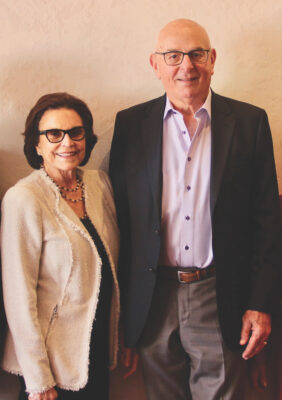
LUNCHEON SPEAKER Wayne Ratkovich and Jo Ann.
Last month, the Larchmont Chronicle featured the first half of a talk that Windsor Square resident, and “famous real estate developer,” Wayne Ratkovich presented to the Auxiliary of the Hospital of the Good Samaritan in the spring of last year.
Also last month, Wayne received another accolade, being honored on December 8 by the USC Architectural Guild as recipient of the Guild’s 2020 Distinguished Business Leadership Award. The award was presented at the organization’s 61st annual awards “dinner” — a Zoom gathering, of course.
But back to last year’s luncheon. There, Wayne told the guests that he would “share some thoughts about Los Angeles including what I think are the agents of change in Los Angeles and in cities throughout our country and the world.” He said he would conclude those thoughts by recounting his own company’s “experience with historic preservation and what I have discovered about the importance of preservation over the past few decades.”
As I noted last month, this talk took place in May of 2019, a year before COVID-19 arrived. But the talk covers a long stretch of Los Angeles history, a period that included the arrival and departure of the Spanish Flu, as well as other detours on the road to where our city is today and where it is going. Regardless of the coronavirus bump in the road, I find Wayne’s predictions for the future to be sound, and I believe readers will find this conclusion of his talk to be as interesting as the first part.
[The first part of this talk, that appeared last month, covered the first two of three 50-year periods: 1900 to 1950 and, then, 1950 to 2000.]
THE CITY
Part II
By Wayne Ratkovich
2000 to 2050

BOTTEGA LOUIE’S vibrant (and noisy) rooms — packed with people — are part of the newly-active DTLA.
Just prior to the turn of the 21st century, Staples Center opened at the corner of 11th and Figueroa. Decades in the planning phase, the Cathedral of Our Lady of the Angels opened in 2002, and the next year the Frank Gehry-designed Walt Disney Concert Hall made its debut.
These very significant additions were the first signs that a new era for downtown had begun.
Staples opened with over 225 events each year, serving as the home court for the Lakers, the Clippers, the Sparks and the Kings, and as a venue for awards shows and concerts. In 2008, the Anschutz Entertainment Group, or AEG, opened L.A. Live. Now, between Staples and L.A. Live, there are over 300 live events each year.
Anschutz went on to assemble 45 acres in the South Park area of downtown and did more to stimulate development in South Park than the city’s redevelopment agency had accomplished in 30 years.
In one of those all-too-seldom moments, the city council of Los Angeles passed constructive legislation in 1999 called the Adaptive Reuse Ordinance, a law that exempted historic buildings and other older structures from having to strictly conform to zoning codes and building regulations. Easing these regulations sparked a very significant amount of renovation and produced a wave of new housing for downtown.
Millennials everywhere
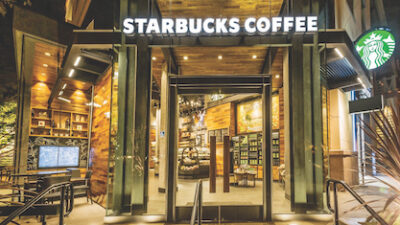
SOCIALIZATION is an aspect of urbanization.
The most significant factor in the rebirth of downtown — at least in my view – is one of demographics. The “millennials” are the largest demographic cohort in our country today, outnumbering the baby boomers by over two million. This is the generation born after 1980. You see them everywhere, and their influence is profound.
This is a generation that glories in technology and uses it at every step of life. It is the generation that is changing the way we dress, the way we work, the restaurants we dine in and the entertainment we enjoy. I view The California Club’s decision to allow male members and guests to enter without ties as a signal that times have truly changed. I confess that I showed up here this morning without a tie, hoping you would mistake me for a millennial!
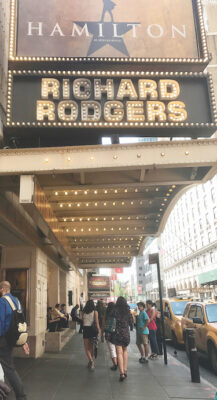
URBAN MEETING PLACES include theaters.
It is almost impossible to keep track of the number of restaurants and bars opening downtown — it seems like a weekly occurrence. Most notable among them is Bottega Louie at Seventh Street and Grand Avenue. The restaurant’s annual volume is an incredible $24 million, which must rank it number one in the city. I warn you about going to Bottega Louie — it is very noisy and filled with the voices of those ever-present millennials.
You have all heard about the amount of residential construction underway downtown. One of the major residential developers recently completed a survey of downtown projects that he believed had strong sponsorship and were likely to be completed. The total he identified exceeded 7,000 residential units.
So, what is one to make of all this? It seems to me that we are witnessing the return of the city and not simply the construction of office buildings and an occasional hotel. The opportunity for the 50 years stretching from 2000 to 2050 is one of building a true city, and it is a very big opportunity.
Listen to the words of a recent article in “GQ Magazine” titled “America’s Next Great City is Inside L.A.” — “For decades Downtown has been the dark center of L.A. … a wasteland of half-empty office buildings and fully empty streets. But amid the glittering towers and crumbly Art Deco facades, a new generation of adventurous chefs, bartenders, loft dwellers, artists and developers are creating a neighborhood as electrifying and gritty as New York in the 70s. [It is the] coolest downtown in America.”
There are many reasons for the return to the city so let’s talk about a few.
Urbanization
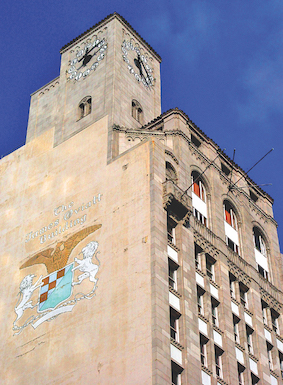
OVIATT Building on Olive St., south of Sixth.
In 1990, the American Institute of Architects, the AIA, polled its members asking them to rate a list of 10 trends that the organization had identified. When the survey was in, the number one trend by a healthy margin was “The urbanization of suburbia.”
The architects were focused on the United States and they were right on. But what they spotted was a part of urbanization on a global scale. Today, more than half of the world’s population lives in urban areas.
My source for the following is Oxford University’s website, ourworldindata.org.
In 1900, 39 percent of the U.S. population lived in urban areas. By 1950, it was 64 percent, by 2000 it climbed to 79 and by 2016 it was 81 percent.
This trend was not limited to the U.S. In 1900, 16 percent of the world’s population lived in urban areas. By 1950, it almost doubled to 30 percent, and in 2016 it almost doubled again to 54 percent.
Let’s go to China. In 1900, the urban percentage was 6.6, by 1950 it was 13.4 percent and by 2016 it was 54 percent.
Socialization
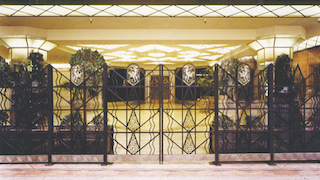
OVIATT lobby features restored René Lalique glass and serves as the entry to the restaurant in the former haberdashery.
Certainly, one of the things we humans enjoy is one another. Socialization is one of the reasons for urbanization and certainly one of its benefits. In the early 1990s, did any of us really believe that a coffee company in Seattle was going to succeed in selling $4 cups of coffee to middle income-America? Today, Starbucks is a local hangout in nearly every community in our country — check that, in our world! Coffee drinkers come alone and bring their laptops or iPads and work away while their senior citizen friends simply gather at a nearby table to debate the world’s issues.
A few years ago, Jo Ann and I treated ourselves to two tickets to “Hamilton” in New York City. We arrived early, found our seats and engaged in a conversation with a lovely lady who shared with us her interesting story. She and her husband raised their family in a suburb of New York City. Her children, now raised with families of their own, still live in nearby suburbs. When her husband died, she made a very big and bold decision — she moved to New York City!
As a long-time tennis player, she found and joined a club in the city and made new friends. She imposed some rules upon herself. One was to never drink her morning coffee in her home — always out to the city and to new friends. Another was to ride the bus to wherever she may be headed, and now her closest city friend was a fellow bus rider. She came to love the theater and found a way to deal with the expense.
She learned that for every show there is someone that has fallen ill, missed an airplane or had some similar misfortune that made their attendance impossible and their ticket available. She learned that there is a separate and usually quite short line for these tickets and she also learned that there was an “app” called “I will stand for you.” At an affordable cost she was able to visit New York theaters weekly. The night we met, a granddaughter was her guest in a single seat a row or two away. I tried not to dwell on how the cost of her tickets compared to ours!
The role of the city
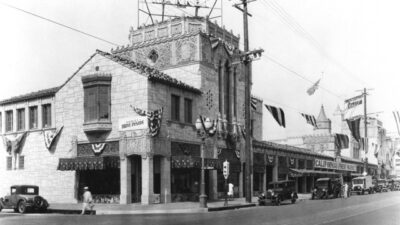
CHAPMAN MARKET was a community marketplace on Sixth Street between Alexandria and Kenmore avenues.
Cities play such an important role in our lives. In a “Time” magazine cover story, James Rouse, the developer of the City of Columbia, Maryland; Faneuil Hall Marketplace in Boston; and Harborplace in Baltimore, once put it this way: “The only legitimate purpose of a city is to provide for the life and growth of its citizens.’’ If we accept the urbanization numbers as accurate, our cities must be succeeding in meeting Rouse’s standard.
We share our lives together in the city in so many inspiring and helpful ways. Gifted musicians share their talents at the concert hall, actors in the theaters and on the screens, artists in the museums, athletes on the fields, chefs in their kitchens, cops on the street, first responders when we desperately need them, educators at schools and universities, nurses and doctors at hospitals and ministers in our churches. And that is just getting started.
If we need or want something, it will be found in the city. An author whose name I cannot recall once said, “If you want your hair dyed purple at three o’clock in the morning, you can find such a service in New York City.”
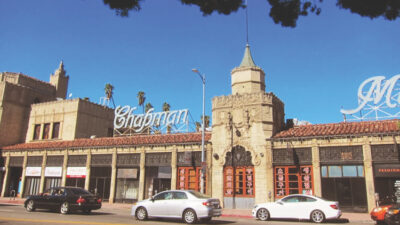
CHAPMAN RESTORED has lively shops and is a popular Koreatown destination.
The city presents us with an opportunity to fill important and needed economic roles whether as an employee or as the owner of an enterprise. These economic opportunities provide the resources to live a full and good life as we explore and experience the richness of the city.
It is inevitable that as we gather in the city, challenges do emerge. Today, cities seek to achieve sustainability, the desire to function fully, efficiently and independently while preserving the opportunity for future generations to do likewise. Cities also seek to achieve resiliency, a strategy to return to form from disasters of all types and from all sources.
And let’s not overlook the dark side of cities — crime is an ever-present challenge in the city as the nightly news constantly reminds us. I won’t go down the list you already know too well, but I am compelled to make a reference to homelessness. Homelessness is a disease of the city and a serious and a growing one. You and I and everyone we know must urge our elected officials to do more than give speeches. It is time for them to take immediate and bold action or step aside for someone who will. The future of our cities is at stake.
The preservation of historic buildings — buildings distinguished by their history or their architecture — connects us to the history of our city. And for those of us old enough to be the parents of millennials, they connect us to important memories of our own lives. How many of us remember shopping at Bullock’s Wilshire or boarding a train at Union Station?
My developing
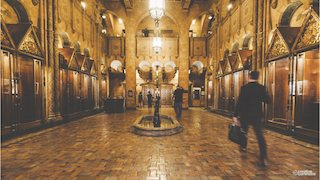
FINE ARTS LOBBY has been restored to its original grandeur.
After five years as a developer of industrial properties, I purchased the Oviatt Building in 1977. I bought it from the Archdiocese of Los Angeles for $500,000, about $5 per square foot for the 100,000-square-foot building. The property was priced expecting the building would be demolished and the property would be more economically successful as a parking lot.
We concluded that market conditions supported a renovation of the building. Just two weeks into our ownership, a lovely lady from the city came to our office to congratulate us with the news that the Oviatt Building had been named a historic-cultural landmark. We had no idea what that meant, but there was nothing we could do about it. We decided to make it part of our marketing of the building, and it worked magically. We got as much press attention as a million-square-foot building on Bunker Hill, and tenants flowed into the building, attracted by its historic status. The building became the home of Rex, Il Ristorante, the most elegant restaurant in Los Angeles and for 17 years one of its most successful.
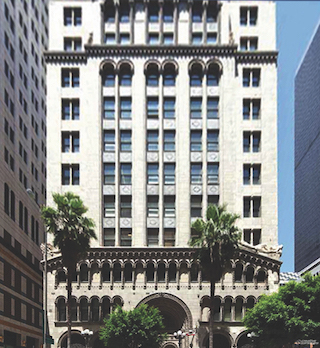
FINE ARTS LOBBY has been restored to its original grandeur.
The experience with the Oviatt changed forever my role as a developer. I no longer had interest in factories and warehouses. I realized that my little company could make a positive difference in the city, and it was something I wanted to continue to do. I changed the mission statement of my company to read that our mission was “to profitably produce developments that improve the quality of urban life.” That remains our mission statement today.
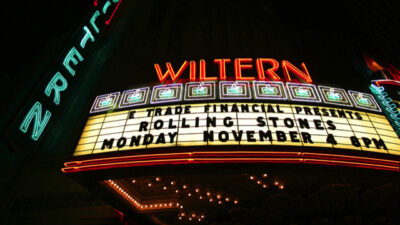
WILTERN THEATER, an early Ratkovich restoration success.
I felt so much more relevance in following this mission, rather than developing industrial buildings. The industrial buildings offered no connection to the past or to the future, and they gave my life so little purpose. Susan Orlean, author of “The Library Book,” said it best with this insightful bit of wisdom in her book: “If you see something that can be set down and saved, and if you can see your life reflected in previous lives, and if you can see it reflected in subsequent ones, you can begin to discover order and harmony. You know that you are part of a larger story that has shape and purpose — a tangible, familiar past and a constantly refreshed future.”
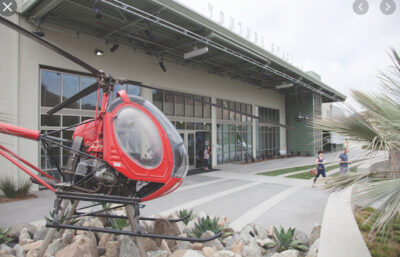
GOOGLE values history, as shown by the restored Hughes helicopter placed outside the new YouTube offices in a former Hughes Aircraft Co. warehouse in Playa Vista
From the Oviatt came the Wiltern Theater, the Pellissier Building, Chapman Market, the Fine Arts Building and the 11-building campus of the former headquarters for Hughes Aircraft Company in Playa Vista.
My, how things have changed!
A city once known for destroying landmarks now has the largest historic preservation organization in the nation, the Los Angeles Conservancy. Google — a company of 29-year-olds (only a slight exaggeration) — knows that its employees value their place in history. When they moved into a former Hughes Aircraft Company warehouse, they then purchased, decommissioned and installed a Hughes-made helicopter as an historic sculpture at the building’s entry.
Category: Real Estate
